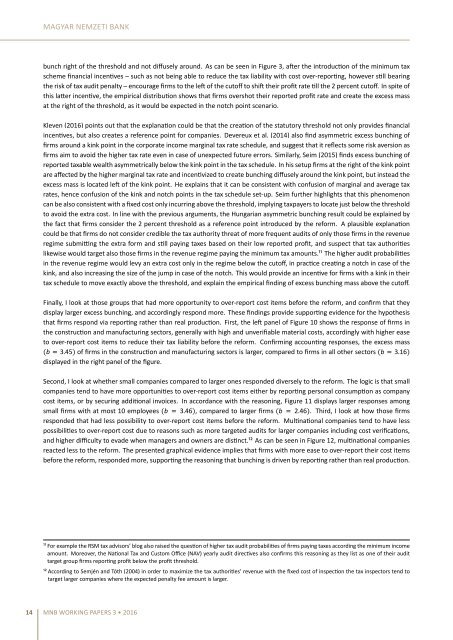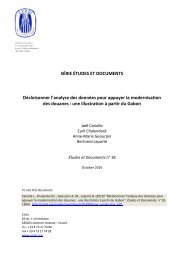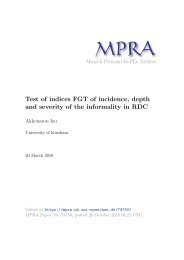Create successful ePaper yourself
Turn your PDF publications into a flip-book with our unique Google optimized e-Paper software.
MAGYAR NEMZETI BANK<br />
bunch right of the threshold and not diffusely around. As can be seen in Figure 3, aer the introducon of the minimum tax<br />
scheme financial incenves – such as not being able to reduce the tax liability with cost over-reporng, however sll bearing<br />
the risk of tax audit penalty – encourage firms to the le of the cutoff to shi their profit rate ll the 2 percent cutoff. In spite of<br />
this laer incenve, the empirical distribuon shows that firms overshot their reported profit rate and create the excess mass<br />
at the right of the threshold, as it would be expected in the notch point scenario.<br />
Kleven (2016) points out that the explanaon could be that the creaon of the statutory threshold not only provides financial<br />
incenves, but also creates a reference point for companies. Devereux et al. (2014) also find asymmetric excess <strong>bunching</strong> of<br />
firms around a kink point in the corporate income marginal tax rate schedule, and suggest that it reflects some risk aversion as<br />
firms aim to avoid the higher tax rate even in case of unexpected future errors. Similarly, Seim (2015) finds excess <strong>bunching</strong> of<br />
reported taxable wealth asymmetrically below the kink point in the tax schedule. In his setup firms at the right of the kink point<br />
are affected by the higher marginal tax rate and incenvized to create <strong>bunching</strong> diffusely around the kink point, but instead the<br />
excess mass is located le of the kink point. He explains that it can be consistent with confusion of marginal and average tax<br />
rates, hence confusion of the kink and notch points in the tax schedule set-up. Seim further highlights that this phenomenon<br />
can be also consistent with a fixed cost only incurring above the threshold, implying taxpayers to locate just below the threshold<br />
to avoid the extra cost. In line with the previous arguments, the Hungarian asymmetric <strong>bunching</strong> result could be explained by<br />
the fact that firms consider the 2 percent threshold as a reference point introduced by the reform. A plausible explanaon<br />
could be that firms do not consider credible the tax authority threat of more frequent audits of only those firms in the revenue<br />
regime subming the extra form and sll paying taxes based on their low reported profit, and suspect that tax authories<br />
likewise would target also those firms in the revenue regime paying the minimum tax amounts.¹¹ The higher audit probabilies<br />
in the revenue regime would levy an extra cost only in the regime below the cutoff, in pracce creang a notch in case of the<br />
kink, and also increasing the size of the jump in case of the notch. This would provide an incenve for firms with a kink in their<br />
tax schedule to move exactly above the threshold, and explain the empirical finding of excess <strong>bunching</strong> mass above the cutoff.<br />
Finally, I look at those groups that had more opportunity to over-report cost items before the reform, and confirm that they<br />
display larger excess <strong>bunching</strong>, and accordingly respond more. These findings provide supporng <strong>evidence</strong> for the hypothesis<br />
that firms respond via reporng rather than real producon. First, the le panel of Figure 10 shows the response of firms in<br />
the construcon and manufacturing sectors, generally with high and unverifiable material costs, accordingly with higher ease<br />
to over-report cost items to reduce their tax liability before the reform. Confirming accounng responses, the excess mass<br />
(b 3.45) of firms in the construcon and manufacturing sectors is larger, compared to firms in all other sectors (b 3.16)<br />
displayed in the right panel of the figure.<br />
Second, I look at whether small companies compared to larger ones responded diversely to the reform. The logic is that small<br />
companies tend to have more opportunies to over-report cost items either by reporng personal consumpon as company<br />
cost items, or by securing addional invoices. In accordance with the reasoning, Figure 11 displays larger responses among<br />
small firms with at most 10 employees (b 3.46), compared to larger firms (b 2.46). Third, I look at how those firms<br />
responded that had less possibility to over-report cost items before the reform. Mulnaonal companies tend to have less<br />
possibilies to over-report cost due to reasons such as more targeted audits for larger companies including cost verificaons,<br />
and higher difficulty to evade when managers and owners are disnct.¹² As can be seen in Figure 12, mulnaonal companies<br />
reacted less to the reform. The presented graphical <strong>evidence</strong> implies that firms with more ease to over-report their cost items<br />
before the reform, responded more, supporng the reasoning that <strong>bunching</strong> is driven by reporng rather than real producon.<br />
¹¹ For example the RSM tax advisors’ blog also raised the queson of higher tax audit probabilies of firms paying taxes according the minimum income<br />
amount. Moreover, the Naonal Tax and Custom Office (NAV) yearly audit direcves also confirms this reasoning as they list as one of their audit<br />
target group firms reporng profit below the profit threshold.<br />
¹² According to Semjén and Tóth (2004) in order to maximize the tax authories’ revenue with the fixed cost of inspecon the tax inspectors tend to<br />
target larger companies where the expected penalty fee amount is larger.<br />
14 MNB WORKING PAPERS 3 • 2016





